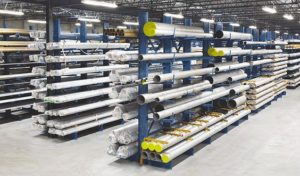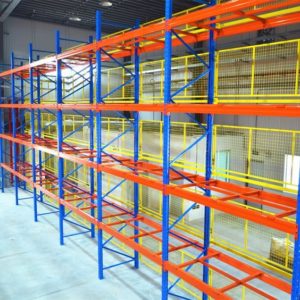Steel Warehouse Pallet Racking: Optimizing Storage for Modern Warehousing
In the contemporary logistics and warehousing industry, the demand for efficient storage solutions is higher than ever. With increasing pressure to optimize space, reduce costs, and improve inventory management, businesses are turning to advanced storage systems. One of the most effective and durable solutions available is steel warehouse pallet racking. This article delves into the various types of steel pallet racking systems, their benefits, applications, and key considerations when implementing them in a warehouse setting.

What is Steel Warehouse Pallet Racking?
Steel warehouse pallet racking is a storage solution designed to hold palletized goods in a warehouse. Made from high-strength steel, these racks are engineered to support heavy loads and withstand the rigors of industrial use. They allow for the organized storage of large quantities of goods, optimizing both vertical and horizontal space in a warehouse.
Types of Steel Warehouse Pallet Racking Systems
There are several types of steel pallet racking systems, each suited to different storage needs and warehouse configurations. Here are some of the most common types:
1. Selective Pallet Racking
Selective pallet racking is the most common type of racking system. It allows for direct access to each pallet, making it highly versatile and suitable for a wide range of products. This system consists of upright frames and horizontal beams, which can be adjusted to accommodate different pallet sizes and weights. The primary advantage of selective pallet racking is its accessibility, ensuring quick and easy retrieval of any pallet.
2. Drive-In and Drive-Through Racking
Drive-in and drive-through racking systems are designed for high-density storage. These systems minimize the need for aisles, allowing forklifts to drive directly into the rack structure to load and unload pallets. Drive-in racking has a single entry and exit point, while drive-through racking has two, offering greater flexibility. These systems are ideal for storing large quantities of similar items that do not require frequent rotation.
3. Push Back Racking
Push back racking systems use a series of nested carts on inclined rails. When a new pallet is loaded, it pushes the previous pallets back. When a pallet is removed, the remaining pallets roll forward. This system allows for high-density storage and better space utilization, as multiple pallets can be stored on each level. Push back racking is suitable for medium-turnover products.
4. Pallet Flow Racking
Pallet flow racking, or gravity flow racking, uses inclined rollers to move pallets from the loading end to the picking end. This system supports a first-in, first-out (FIFO) inventory management approach, making it ideal for perishable goods and items with expiration dates. Pallet flow racking maximizes storage density and ensures efficient product rotation.
5. Cantilever Racking
Cantilever racking is designed for storing long, bulky items such as pipes, lumber, and sheet materials. It features arms that extend from a central column, allowing for unobstructed storage of items of varying lengths. Cantilever racking systems are highly adaptable and can be adjusted to accommodate different load sizes and weights.
6. Double-Deep Racking
Double-deep racking is a variation of selective racking where pallets are stored two deep instead of one. This system increases storage density by reducing the number of aisles required. However, it limits direct access to pallets, as only the front pallet is immediately accessible. Double-deep racking is suitable for warehouses with lower turnover rates.

Benefits of Steel Warehouse Pallet Racking
Implementing steel warehouse pallet racking offers numerous benefits that enhance operational efficiency and safety. Here are some key advantages:
1. Maximized Space Utilization
Steel pallet racking systems are designed to optimize the use of vertical and horizontal space in a warehouse. By storing items in tall racks and utilizing the full height of the warehouse, businesses can significantly increase their storage capacity without expanding the physical footprint.
2. Durability and Strength
Made from high-strength steel, these racking systems are built to withstand heavy loads and harsh industrial environments. They offer long-lasting durability, reducing the need for frequent replacements and repairs.
3. Improved Inventory Management
These systems facilitate better organization and accessibility of inventory, making it easier to locate and retrieve items quickly. This leads to improved inventory accuracy, reduced handling times, and increased overall productivity.
4. Enhanced Safety
Steel pallet racking systems are engineered to support substantial weight loads, reducing the risk of rack failure and associated accidents. They are designed with safety features such as load-bearing beams, safety pins, and braces to ensure stability and secure storage.
5. Cost Efficiency
By maximizing storage space and improving inventory management, steel pallet racking systems help reduce operational costs. Businesses can save on space rental or construction costs and minimize labor expenses through more efficient handling and retrieval processes.
6. Scalability and Flexibility
These systems are highly customizable and can be adjusted or expanded as storage needs change. This flexibility allows businesses to adapt their storage solutions to accommodate growth and evolving inventory requirements.

Applications in Various Industries
Steel warehouse pallet racking systems are used across a wide range of industries to improve storage efficiency and operational workflows. Here are some examples of how these systems are applied:
1. Manufacturing
In manufacturing facilities, steel pallet racking systems are used to store raw materials, work-in-progress items, and finished goods. These systems ensure that essential materials are readily available for production processes, minimizing downtime and enhancing productivity.
2. Distribution and Logistics
Distribution centers and logistics hubs rely on steel pallet racking systems to manage large volumes of goods efficiently. These systems support fast and accurate order fulfillment, helping to meet customer demands and reduce lead times.
3. Retail
Large retail stores and warehouses use steel pallet racking systems to organize and store merchandise. This allows for better inventory control, quicker restocking, and improved overall store operations.
4. Food and Beverage
The food and beverage industry uses steel pallet racking systems to store perishable and non-perishable goods. Systems like pallet flow racking ensure proper stock rotation and easy access to products with expiration dates, maintaining product quality and safety.
5. Automotive
In the automotive industry, steel pallet racking systems store heavy and bulky items such as engines, transmissions, and body parts. These systems provide safe and efficient storage, ensuring that parts are easily accessible for assembly or repair operations.
6. Pharmaceuticals
Pharmaceutical companies use steel pallet racking systems to store raw materials, active ingredients, and finished products. These systems help maintain organization, ensure compliance with regulatory standards, and facilitate efficient inventory management.

Factors to Consider When Choosing Steel Warehouse Pallet Racking
Selecting the right steel pallet racking system for your facility requires careful consideration of several factors. Here are some key considerations to keep in mind:
1. Type of Inventory
Consider the size, weight, and shape of the items you need to store. This will determine the type of racking system that best suits your needs. For example, cantilever racking is ideal for long, bulky items, while pallet flow racking is suitable for products with high turnover rates.
2. Space Availability
Evaluate the available floor and vertical space in your facility. Steel pallet racking systems can maximize vertical space, but you need to ensure there is enough clearance for safe operation of material handling equipment such as forklifts.
3. Load Capacity
Ensure that the chosen racking system can support the weight of your inventory. Overloading racks can lead to structural failure and pose significant safety risks. Always adhere to the manufacturer’s load capacity guidelines.
4. Accessibility
Determine how frequently you need to access your stored items. If quick and direct access is essential, selective pallet racking might be the best option. For items that are not accessed frequently, drive-in or push back racking systems may be more suitable.
5. Safety Requirements
Consider the safety features of the racking system, such as load-bearing capacity, stability, and the inclusion of safety pins and braces. Compliance with industry safety standards and regulations is crucial to ensure the well-being of workers and the protection of stored goods.
6. Future Expansion
Choose a racking system that can be easily adjusted or expanded to accommodate future growth. Scalability is important for businesses that anticipate changes in inventory levels or types over time.

Case Study: Implementing Steel Pallet Racking in a Warehouse
To illustrate the benefits and implementation process of steel warehouse pallet racking, let’s examine a case study of a distribution center.
Background
XYZ Distribution, a leading logistics company, faced challenges with limited storage space and inefficient inventory management in their warehouse. As their business expanded, the need for a more efficient storage solution became critical.
Challenges
- Limited floor space for expanding storage capacity
- Difficulty in accessing stored items, leading to delays in order fulfillment
- Safety concerns due to overcrowded and unstable storage areas
Solution
XYZ Distribution implemented a combination of selective pallet racking and pallet flow racking systems. Selective pallet racking was used for storing a wide variety of products, while pallet flow racking was installed for high-turnover items that required FIFO inventory management.
Results
- Increased Storage Capacity: The new racking systems allowed XYZ Distribution to utilize vertical space, significantly increasing their storage capacity without expanding the warehouse footprint.
- Improved Accessibility: Items were organized more efficiently, enabling faster retrieval and reducing delays in order fulfillment.
- Enhanced Safety: The robust and stable racking systems reduced the risk of accidents and improved overall safety in the warehouse.
- Cost Savings: By optimizing space and improving inventory management, XYZ Distribution reduced operational costs and improved productivity.

Steel warehouse pallet racking systems are essential for businesses seeking to optimize their storage space, improve inventory management, and enhance operational efficiency. With various types of racking systems available, companies can select solutions tailored to their specific needs, whether for storing heavy machinery parts, perishable goods, or retail merchandise. By considering factors such as inventory type, space availability, load capacity, and safety requirements, businesses can implement the most effective storage solutions to support their growth and operational goals. Steel pallet racking systems are not just a practical necessity; they are a strategic investment in the future success and efficiency of any industrial or commercial operation.
Hubungi Marketing Kami Sekarang!
Untuk memesan atau mendapatkan informasi lebih lanjut tentang STEEL WAREHOUSE PALLET RACKING SYSTEM / rak gudang kapasitas besar untuk warehouse industri, hubungi tim marketing kami di:
Telepon: 021-87786434 / 87786435 / 87786436
WhatsApp: 081288551012 / 081296786785 / 082184497726
Tim kami siap membantu Anda memilih produk yang tepat dan menjawab semua pertanyaan Anda.
Terima kasih,


